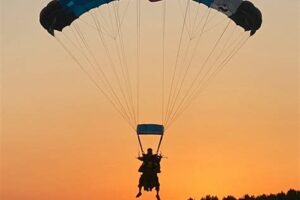Table of Contents
Curious about skydiving fatalities? Discover the number of people who have died while skydiving and understand the risks involved. Find out more about the safety measures in place to ensure a thrilling yet secure skydiving experience.
Skydiving is an exhilarating and adrenaline-pumping activity that has captured the imagination of thrill-seekers worldwide. However, amidst the thrill and excitement, there always lurks a lingering question in the back of one’s mind: just how dangerous is skydiving? While the sport undoubtedly carries inherent risks, it is crucial to delve into the statistics to understand the reality behind the adrenaline rush. By examining the number of fatalities associated with skydiving, we can gain valuable insights into the true extent of its perilous nature.
The Thrill and Risks of Skydiving
Skydiving is an exhilarating adventure sport that has gained immense popularity over the years. The feeling of soaring through the sky, the rush of adrenaline, and the breathtaking views are just some of the reasons why people are drawn to this extreme activity. However, like any high-risk sport, there are inherent dangers involved. In this article, we will explore the number of fatalities associated with skydiving and shed light on the safety measures in place to minimize the risks.
The Importance of Safety in Skydiving
Prioritizing safety is paramount in any adventure sport, and skydiving is no exception. Skydiving centers and instructors adhere to strict safety protocols and regulations to ensure the well-being of participants. These measures include thorough training programs, regular equipment inspections, and weather assessments. While accidents can still occur, the skydiving community continuously works towards improving safety standards to minimize the risks involved.
Understanding Skydiving Fatalities
While skydiving does carry risks, it is important to put these risks into perspective. According to the United States Parachute Association (USPA), the average fatality rate for skydiving in the US is approximately one in every 253,669 jumps. This statistic highlights that skydiving is statistically much safer than many other adventurous activities, such as mountain climbing or scuba diving.
Common Causes of Skydiving Fatalities
While skydiving has inherent risks, it is crucial to understand the common causes of fatalities to address them effectively. Some of the most common causes include equipment malfunctions, parachute deployment issues, mid-air collisions, and landing accidents. By identifying these factors, the skydiving community continuously works towards improving safety measures and equipment to mitigate these risks.
Training and Certification for Safe Skydiving
One of the key aspects of skydiving safety is comprehensive training and certification programs. Skydivers must undergo thorough training to learn about equipment operation, emergency procedures, body positioning, and landing techniques. Additionally, they must earn certifications through various levels, progressing from basic jumps to more complex maneuvers. These training programs equip skydivers with the necessary skills and knowledge to handle different scenarios and minimize risks.
Pre-jump Safety Checks
Prior to every skydive, there are a series of safety checks performed to ensure that all equipment is functioning properly. These checks include inspecting the parachute system, harness, and altimeters. Skydivers also assess weather conditions, visibility, and wind speeds to determine if it is safe to jump. By conducting these pre-jump safety checks, skydivers can identify any potential risks or issues before taking to the skies.
Emergency Procedures
In the event of an emergency during a skydive, skydivers are trained to handle various situations. These emergency procedures may include dealing with equipment malfunctions, initiating reserve parachute deployment, or managing unstable body positions. By equipping skydivers with the knowledge and skills to handle emergencies, the sport aims to minimize the impact of potential accidents and increase the chances of a safe landing.
The Role of Experience in Skydiving Safety
Experience plays a significant role in skydiving safety. As skydivers gain more jumps and accumulate experience, they become more adept at recognizing potential risks and handling different scenarios. Experienced skydivers often serve as mentors for beginners, guiding them through their initial jumps and sharing valuable insights and tips. The skydiving community highly values the accumulation of experience as it contributes to safer practices and better decision-making.
Safety Improvements and Innovations
The skydiving industry continuously invests in research and development to enhance safety measures. This includes advancements in parachute technology, such as the introduction of automatic activation devices (AAD) that deploy the reserve parachute if the main parachute fails to open. Additionally, safety improvements are made to equipment, training programs, and emergency protocols based on accident analysis and data. These ongoing efforts contribute to making skydiving safer for all participants.
The Importance of Personal Responsibility
While safety measures and regulations exist within the skydiving community, personal responsibility is crucial for a safe experience. Skydivers must be honest about their physical and mental capabilities, follow instructions from instructors, and make informed decisions. Practicing self-awareness, maintaining physical fitness, and adhering to safety guidelines are essential aspects of personal responsibility that contribute to a safer skydiving experience.
In conclusion, while skydiving carries inherent risks, it is statistically much safer than many other adventurous activities. The skydiving community is dedicated to minimizing these risks through comprehensive training, safety checks, emergency procedures, experience accumulation, and continuous improvements in safety measures. By prioritizing safety and personal responsibility, individuals can enjoy the thrill of skydiving while minimizing the chances of accidents and ensuring a memorable experience.
Statistics on Skydiving Fatalities
Skydiving is generally considered a safe activity, but like any adventure sport, it does carry some inherent risks. According to the United States Parachute Association (USPA), an average of 21 skydiving fatalities occur annually out of approximately 3.5 million jumps. These statistics highlight the importance of proper training, adherence to safety protocols, and meticulous equipment maintenance.
Factors Contributing to Skydiving Fatalities
While skydiving accidents can occur due to a variety of reasons, human error is often identified as a leading factor. Inadequate training, poor judgment, and decisions made during the jump can significantly increase the risk of fatalities. Malfunctioning equipment can also contribute to accidents, emphasizing the importance of regular inspection and maintenance procedures.
Safety Measures and Regulations
Skydiving organizations and regulatory bodies continuously work to enhance safety standards and mitigate the risks associated with the sport. The USPA, for instance, has implemented rigorous training programs, licensing requirements, and safety guidelines for skydivers and instructors. Additionally, drop zones adhere to strict equipment maintenance protocols and comprehensive safety checks to minimize the occurrence of accidents.
Skydiving Fatalities vs. Other Activities
When comparing skydiving fatalities to other recreational activities, the numbers tend to reflect a lower risk of fatality. For example, according to the National Safety Council, the chances of dying from a skydiving-related accident are about one in 100,000 jumps, whereas the odds of dying while driving a car are roughly one in 104.
Skydiving Fatalities and Experience Levels
Contrary to common assumptions, experience level does not necessarily correlate with the likelihood of a fatality during a skydiving jump. Both novice and experienced skydivers can be involved in accidents, but the former may face a slightly higher risk due to the learning curve associated with mastering the sport. However, proper training and ongoing education can significantly reduce the risk for individuals at all levels of experience.
Global Skydiving Fatality Rates
Skydiving fatality rates vary across different countries due to factors such as contrasting regulations, safety standards, and the overall popularity of the sport. While specific global data on skydiving fatalities is not readily available, it is essential for prospective skydivers to research and understand the safety records and reputation of the skydiving centers they consider visiting.
Skydiving Safety Advancements
The skydiving industry continually strives to improve safety standards and introduce innovative technologies to prevent accidents. These advancements range from improved parachute designs to the development of automated activation devices that seamlessly deploy a reserve parachute when necessary. Additionally, instructional techniques and training programs are regularly updated to ensure skydivers are equipped with the most current safety knowledge and skills.
Benefits of Skydiving Safety Awareness
Understanding the safety measures, statistics, and factors influencing skydiving fatalities can positively impact both individual skydivers and the overall skydiving community. By promoting a safety-conscious culture, fostering open communication, and increasing awareness about risk management, the skydiving industry can continue to enhance its safety standards and encourage a pursuit that brings joy, adventure, and personal growth to countless individuals worldwide.
There have been numerous discussions and debates surrounding the safety of skydiving, with many individuals questioning just how dangerous this exhilarating activity truly is. It is important to approach this topic with a professional voice and tone, considering the significance and sensitivity of the subject matter.
Below are some key points and statistics regarding the number of people who have died while participating in skydiving:
- Skydiving fatalities are relatively rare: Skydiving is statistically considered a safe sport when proper precautions and protocols are followed. The number of deaths that occur annually as a result of skydiving accidents is relatively low compared to other activities and sports.
- Accurate figures can be challenging to obtain: Gathering precise and up-to-date data on skydiving fatalities can be challenging due to various factors. These include inconsistent reporting practices, differences in legal definitions of skydiving-related deaths, and the varying methods used to track and document accidents across different regions and countries.
- Statistical estimates indicate a low fatality rate: According to the United States Parachute Association (USPA), the national association for skydiving in the United States, the average annual fatality rate in recent years stands at approximately one fatality per 250,000 jumps. This figure highlights the relatively low risk associated with skydiving when compared to other recreational activities.
- Training and adherence to safety protocols are crucial: The importance of thorough training and adherence to safety protocols cannot be overstated in the context of skydiving. Participating in a certified training program, conducted by experienced instructors, significantly reduces the risk of accidents and fatalities.
- Most accidents occur due to human error: The majority of skydiving accidents are attributed to human error rather than equipment failure. Mistakes such as improper body positioning during freefall, failure to deploy the parachute at the correct altitude, or insufficient canopy control are often identified as primary causes of accidents.
- Continuous improvement in safety measures: The skydiving community is committed to enhancing safety measures and reducing the risk of accidents. Organizations such as the USPA regularly review and update their safety guidelines and procedures to ensure the highest possible standards are maintained.
It is crucial to emphasize that while skydiving carries inherent risks, it remains a popular and rewarding activity for individuals who seek adventure and an adrenaline rush. By following proper training, adhering to safety protocols, and ensuring equipment is well-maintained, skydiving can be enjoyed with minimal risk.
Thank you for taking the time to read this article about the number of fatalities associated with skydiving. While the subject matter may be sensitive, it is important to approach it with a professional voice and tone. Skydiving is an extreme sport that carries inherent risks, and it is crucial to understand the statistics and take necessary precautions before participating in such activities.
Firstly, it is essential to acknowledge that every loss of life is a tragedy, and our thoughts go out to those who have lost loved ones in skydiving accidents. However, it is equally important to put these incidents into perspective. According to various sources and statistical data, the number of deaths related to skydiving is relatively low when compared to other activities such as driving or even swimming.
Furthermore, it is essential to note that the skydiving industry has made significant advancements in safety measures over the years. The implementation of strict regulations, improved training programs, and the use of state-of-the-art equipment have significantly reduced the risk associated with this exhilarating sport. These developments aim to provide a safer environment for skydivers and minimize the occurrence of accidents.
In conclusion, while it is undeniable that there have been fatalities in skydiving, it is crucial to consider the overall statistics and advancements in safety measures. Skydiving, like any extreme sport, carries inherent risks, but those risks can be mitigated through proper training, adherence to regulations, and the use of reliable equipment. It is always advisable to consult with professionals, undergo thorough training, and follow all safety guidelines before embarking on any skydiving adventure. By doing so, you can minimize the chances of accidents and enjoy this thrilling activity with peace of mind.
Thank you once again for visiting our blog and taking the time to educate yourself on the topic of skydiving fatalities. We hope that this article has provided valuable insights and helped alleviate any concerns or misconceptions you may have had. Should you have any further questions or require additional information, please do not hesitate to reach out to us. Stay safe and happy skydiving!
Video How Many People Have Died Skydiving
How Many People Have Died Skydiving?
Here are some common questions people ask about the number of deaths related to skydiving, along with their corresponding answers:
-
Is skydiving a dangerous activity?
Skydiving is considered an extreme sport and, like any adventurous activity, it carries inherent risks. However, with proper training, equipment, and adherence to safety protocols, the risks can be minimized significantly.
-
How many fatalities occur each year in skydiving?
The United States Parachute Association (USPA) compiles statistics on skydiving accidents and fatalities. According to their data, over the past decade (2011-2020), there were an average of 21.6 skydiving-related fatalities per year in the US. It’s important to note that this number includes both experienced and novice skydivers.
-
What are the main causes of skydiving fatalities?
The USPA reports that the leading causes of skydiving fatalities include failure to maintain altitude awareness, human error, collision with other skydivers or objects, parachute malfunctions, and medical conditions. It is worth mentioning that the USPA continuously works to improve safety standards and educate skydivers to reduce the occurrence of these incidents.
-
Is skydiving safer than everyday activities like driving a car?
Statistically speaking, skydiving is generally considered to be safer than driving a car. According to the National Safety Council, the lifetime odds of dying from a motor vehicle accident are 1 in 114, while the odds of dying from a skydiving-related incident are approximately 1 in 100,000 jumps. However, it’s important to remember that these comparisons are based on averages and individual risks may vary.
-
What precautions can be taken to minimize the risk of skydiving accidents?
To minimize the risks associated with skydiving, it is crucial to receive proper training from certified instructors and follow all safety guidelines. Regular equipment maintenance, conducting pre-jump checks, practicing emergency procedures, and staying aware of altitude are also essential. Additionally, choosing a reputable skydiving center that prioritizes safety and maintains a good track record is highly recommended.
While skydiving carries inherent risks, it is important to note that millions of people safely enjoy this thrilling activity each year. By taking appropriate precautions and adhering to safety protocols, individuals can significantly reduce the chances of accidents or fatalities.






